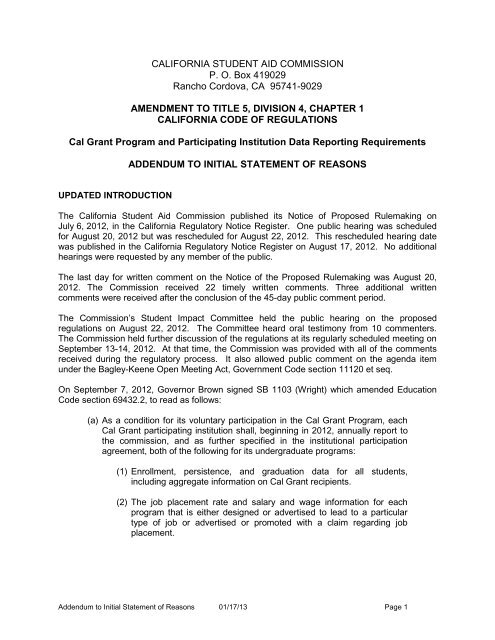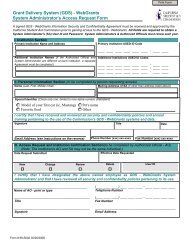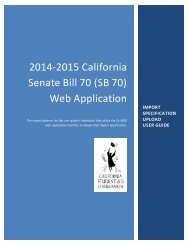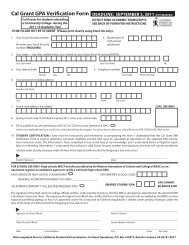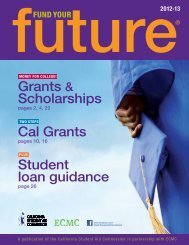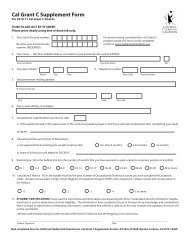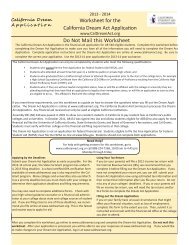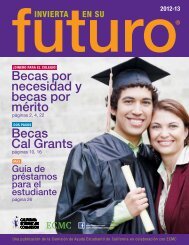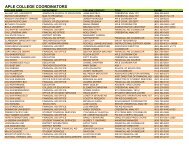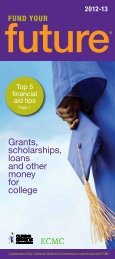Addendum to the Initial Statement of Reasons - CSAC California ...
Addendum to the Initial Statement of Reasons - CSAC California ...
Addendum to the Initial Statement of Reasons - CSAC California ...
Create successful ePaper yourself
Turn your PDF publications into a flip-book with our unique Google optimized e-Paper software.
CALIFORNIA STUDENT AID COMMISSION<br />
P. O. Box 419029<br />
Rancho Cordova, CA 95741-9029<br />
AMENDMENT TO TITLE 5, DIVISION 4, CHAPTER 1<br />
CALIFORNIA CODE OF REGULATIONS<br />
Cal Grant Program and Participating Institution Data Reporting Requirements<br />
ADDENDUM TO INITIAL STATEMENT OF REASONS<br />
UPDATED INTRODUCTION<br />
The <strong>California</strong> Student Aid Commission published its Notice <strong>of</strong> Proposed Rulemaking on<br />
July 6, 2012, in <strong>the</strong> <strong>California</strong> Regula<strong>to</strong>ry Notice Register. One public hearing was scheduled<br />
for August 20, 2012 but was rescheduled for August 22, 2012. This rescheduled hearing date<br />
was published in <strong>the</strong> <strong>California</strong> Regula<strong>to</strong>ry Notice Register on August 17, 2012. No additional<br />
hearings were requested by any member <strong>of</strong> <strong>the</strong> public.<br />
The last day for written comment on <strong>the</strong> Notice <strong>of</strong> <strong>the</strong> Proposed Rulemaking was August 20,<br />
2012. The Commission received 22 timely written comments. Three additional written<br />
comments were received after <strong>the</strong> conclusion <strong>of</strong> <strong>the</strong> 45-day public comment period.<br />
The Commission’s Student Impact Committee held <strong>the</strong> public hearing on <strong>the</strong> proposed<br />
regulations on August 22, 2012. The Committee heard oral testimony from 10 commenters.<br />
The Commission held fur<strong>the</strong>r discussion <strong>of</strong> <strong>the</strong> regulations at its regularly scheduled meeting on<br />
September 13-14, 2012. At that time, <strong>the</strong> Commission was provided with all <strong>of</strong> <strong>the</strong> comments<br />
received during <strong>the</strong> regula<strong>to</strong>ry process. It also allowed public comment on <strong>the</strong> agenda item<br />
under <strong>the</strong> Bagley-Keene Open Meeting Act, Government Code section 11120 et seq.<br />
On September 7, 2012, Governor Brown signed SB 1103 (Wright) which amended Education<br />
Code section 69432.2, <strong>to</strong> read as follows:<br />
(a) As a condition for its voluntary participation in <strong>the</strong> Cal Grant Program, each<br />
Cal Grant participating institution shall, beginning in 2012, annually report <strong>to</strong><br />
<strong>the</strong> commission, and as fur<strong>the</strong>r specified in <strong>the</strong> institutional participation<br />
agreement, both <strong>of</strong> <strong>the</strong> following for its undergraduate programs:<br />
(1) Enrollment, persistence, and graduation data for all students,<br />
including aggregate information on Cal Grant recipients.<br />
(2) The job placement rate and salary and wage information for each<br />
program that is ei<strong>the</strong>r designed or advertised <strong>to</strong> lead <strong>to</strong> a particular<br />
type <strong>of</strong> job or advertised or promoted with a claim regarding job<br />
placement.<br />
<strong>Addendum</strong> <strong>to</strong> <strong>Initial</strong> <strong>Statement</strong> <strong>of</strong> <strong>Reasons</strong> 01/17/13 Page 1
(b) Commencing <strong>the</strong> year after <strong>the</strong> commission begins <strong>to</strong> receive reports<br />
pursuant <strong>to</strong> subdivision (a), <strong>the</strong> commission shall provide both <strong>of</strong> <strong>the</strong><br />
following on its Internet Web site:<br />
(1) The information submitted by a Cal Grant participating institution<br />
pursuant <strong>to</strong> subdivision (a), which shall be made available in a<br />
searchable database.<br />
(2) O<strong>the</strong>r information and links that are useful <strong>to</strong> students and parents<br />
who are in <strong>the</strong> process <strong>of</strong> selecting a college or university. This<br />
information may include, but not be limited <strong>to</strong>, local occupational<br />
pr<strong>of</strong>iles available through <strong>the</strong> Employment Development<br />
Department’s Labor Market Information Data Library.<br />
At its September 13-14, 2012 meeting, <strong>the</strong> Commission heard a staff presentation <strong>of</strong> <strong>the</strong><br />
proposed regulations and heard comments from members <strong>of</strong> <strong>the</strong> public under <strong>the</strong> Bagley-Keene<br />
Open Meeting Act. The Commission requested that staff meet fur<strong>the</strong>r with interested<br />
stakeholders and schedule an additional Commission meeting in Oc<strong>to</strong>ber 2012 <strong>to</strong> discuss <strong>the</strong><br />
proposed regulations.<br />
On Oc<strong>to</strong>ber 4, 2012, Commission staff met with representatives from <strong>the</strong> University <strong>of</strong><br />
<strong>California</strong>, <strong>California</strong> State University, <strong>California</strong> Community Colleges, <strong>the</strong> Association <strong>of</strong><br />
Independent <strong>California</strong> Colleges and Universities, <strong>the</strong> <strong>California</strong> Coalition <strong>of</strong> Accredited Career<br />
Schools, representatives from <strong>the</strong> two financial aid administra<strong>to</strong>r organizations – <strong>the</strong> <strong>California</strong><br />
Association <strong>of</strong> Student Financial Aid Administra<strong>to</strong>rs and <strong>California</strong> Community Colleges Student<br />
Financial Aid Administra<strong>to</strong>rs Association, Representatives from <strong>the</strong> Governor’s Office, <strong>the</strong><br />
Legislative Analyst’s Office, and <strong>the</strong> Assembly Republican Caucus – and o<strong>the</strong>rs <strong>to</strong> discuss and<br />
gain consensus on <strong>the</strong> regulations, including <strong>the</strong> decision <strong>to</strong> remove <strong>the</strong> 2013 job placement<br />
rate and salary and wage reporting requirements from <strong>the</strong> current rulemaking file and for <strong>the</strong><br />
Commission <strong>to</strong> proceed with <strong>the</strong>se items in a separate, future rulemaking filing.<br />
Following <strong>the</strong> meeting <strong>the</strong> Commission made some limited changes <strong>to</strong> <strong>the</strong> text at <strong>the</strong> request <strong>of</strong><br />
<strong>the</strong> stakeholders and deleted certain proposed sections which will be <strong>the</strong> subject <strong>of</strong> a new<br />
rulemaking process in 2013. The Commission deleted sections 30042, 30042.5(a), 30042.5(b),<br />
30042(c)(1), 30042(c)(2), 30042(c)(4), 30042(c)(5), 30042(d)(3), 30042(e)(3), 30043, 30043.5,<br />
and 30044 from <strong>the</strong> proposed rulemaking and renumbered where appropriate.<br />
These amendments <strong>to</strong> <strong>the</strong> proposed regulations on <strong>the</strong> SB 70 reporting requirements<br />
demonstrates that <strong>the</strong> Commission’s goal <strong>to</strong> help students make good choices about higher<br />
education is critical <strong>to</strong> <strong>the</strong>ir success, not only as scholars but as <strong>the</strong> State’s future workforce.<br />
Students and <strong>the</strong>ir parents need pertinent information that is easy <strong>to</strong> access, easy <strong>to</strong> understand<br />
and easy <strong>to</strong> compare. They can search for information <strong>to</strong>day, but it is <strong>of</strong>ten difficult <strong>to</strong> locate,<br />
fragmented across different sources, and steeped in <strong>the</strong> jargon <strong>of</strong> higher education<br />
pr<strong>of</strong>essionals. With <strong>the</strong> rising costs <strong>of</strong> higher education and <strong>the</strong> increasing length <strong>of</strong> time <strong>to</strong><br />
graduation occurring at many institutions, <strong>the</strong> ability <strong>to</strong> accurately compare <strong>the</strong> actual cost and<br />
time <strong>to</strong> degree across institutions has never been more critical.<br />
By establishing specific timeframes for reporting data within six months <strong>of</strong> <strong>the</strong> end <strong>of</strong> an<br />
academic year, <strong>the</strong> Commission will be able <strong>to</strong> provide <strong>to</strong> students and parents up-<strong>to</strong>-date data<br />
on an institution for students and parents <strong>to</strong> evaluate prior <strong>to</strong> making an enrollment decision. In<br />
addition, <strong>the</strong> proposed regulations ga<strong>the</strong>r enrollment, persistence and graduation data on part-<br />
<strong>Addendum</strong> <strong>to</strong> <strong>Initial</strong> <strong>Statement</strong> <strong>of</strong> <strong>Reasons</strong> 01/17/13 Page 2
time students, who are currently not included in many areas <strong>of</strong> <strong>the</strong> federal Integrated<br />
Postsecondary Education Data System (IPEDS) reporting, particularly <strong>the</strong> graduation reporting.<br />
With <strong>the</strong> number <strong>of</strong> part-time students increasing, <strong>the</strong> data is <strong>of</strong> particular interest <strong>to</strong> thousands<br />
<strong>of</strong> students considering postsecondary education.<br />
These proposed regulations also define key terms and add consequences <strong>to</strong> an institution’s<br />
failure <strong>to</strong> report data timely and accurately. This ensures that all institutions are reporting <strong>the</strong><br />
same metrics, and that students and parents making enrollment decisions are being given<br />
equivalent data from which <strong>to</strong> evaluate potential educational choices. Institutions that fail <strong>to</strong><br />
report data, or that report inaccurate or misleading data will be determined <strong>to</strong> be out <strong>of</strong><br />
compliance with its Institutional Participation Agreement.<br />
Lastly, <strong>the</strong> Commission has deleted certain provisions <strong>to</strong> obtain fur<strong>the</strong>r public comment. As<br />
originally proposed, <strong>the</strong> proposed regulations largely mirrored similar reporting that certain<br />
private postsecondary institutions operating under <strong>the</strong> jurisdiction <strong>of</strong> <strong>the</strong> Bureau <strong>of</strong> Private<br />
Postsecondary Education are statu<strong>to</strong>rily required <strong>to</strong> report. These deleted provisions will<br />
become <strong>the</strong> subject <strong>of</strong> a separate rulemaking following fur<strong>the</strong>r consultation.<br />
This addendum <strong>to</strong> <strong>the</strong> <strong>Initial</strong> <strong>Statement</strong> <strong>of</strong> <strong>Reasons</strong> is being noticed <strong>to</strong> <strong>the</strong> public along with <strong>the</strong><br />
15-day Notice <strong>to</strong> provide <strong>the</strong> opportunity <strong>to</strong> <strong>the</strong> public for review and comment on <strong>the</strong> changes<br />
made <strong>to</strong> <strong>the</strong> proposed regulations.<br />
UPDATED ECONOMIC IMPACT ANALYSIS<br />
The Commission has performed an economic analysis pursuant <strong>to</strong> Government Code section<br />
111346.5(a) as set forth below.<br />
The <strong>to</strong>tal statewide dollar costs that businesses may incur <strong>to</strong> comply with this regulation over its<br />
lifetime are unknown, but are limited, and could be virtually eliminated by an institution. For<br />
reporting <strong>the</strong> enrollment, persistence and graduation data, all Cal Grant participating institutions<br />
have <strong>the</strong> option within <strong>the</strong> regulations <strong>to</strong> submit electronically <strong>to</strong> <strong>the</strong> Commission <strong>the</strong> student<br />
unitary data necessary <strong>to</strong> permit <strong>the</strong> Commission <strong>to</strong> prepare <strong>the</strong> report on behalf <strong>of</strong> <strong>the</strong><br />
institution and <strong>the</strong>reby satisfy <strong>the</strong> reporting requirement. It is likely that most institutions already<br />
capture <strong>the</strong> student data necessary <strong>to</strong> create <strong>the</strong> report and all Cal Grant participating<br />
institutions already utilize <strong>the</strong> Commission’s WebGrants system <strong>to</strong> provide data <strong>to</strong> <strong>the</strong><br />
Commission, thus any additional costs incurred by an institution would be negligible, if any, if<br />
<strong>the</strong> institution chooses this method <strong>to</strong> report its data. For institutions that choose <strong>to</strong> compile<br />
data and submit <strong>the</strong> report without <strong>the</strong> assistance <strong>of</strong> <strong>the</strong> Commission, any additional data not<br />
currently being captured by an institution would need <strong>to</strong> be added <strong>to</strong> <strong>the</strong> institution’s information<br />
technology system so that it could be routinely captured by <strong>the</strong> institution and reported, but after<br />
<strong>the</strong> first report it would become an electronic transfer <strong>of</strong> data requiring no cost <strong>to</strong> <strong>the</strong> institution.<br />
The cost for an institution <strong>to</strong> add <strong>the</strong> additional fields <strong>of</strong> data necessary should be negligible.<br />
Where <strong>the</strong>re may be additional costs associated with reporting occurs with <strong>the</strong> job placement<br />
data and salary and wage reporting. The costs associated with this report are also unknown<br />
and will depend upon <strong>the</strong> method <strong>the</strong> institution chooses <strong>to</strong> collect <strong>the</strong> data. Institutions that<br />
choose <strong>to</strong> conduct student surveys may use free survey <strong>to</strong>ols that are available through <strong>the</strong><br />
internet and send electronic mail <strong>to</strong> students. Institutions may choose o<strong>the</strong>r methods, but <strong>the</strong><br />
cost would be within <strong>the</strong> institution’s control based upon <strong>the</strong> method selected; i.e. postage for a<br />
mailed survey; staff time <strong>to</strong> make phone calls, etc. The Commission, by regulation, is <strong>of</strong>fering <strong>to</strong><br />
perform this reporting for <strong>the</strong> <strong>California</strong> Community Colleges if <strong>the</strong> institution will share student<br />
<strong>Addendum</strong> <strong>to</strong> <strong>Initial</strong> <strong>Statement</strong> <strong>of</strong> <strong>Reasons</strong> 01/17/13 Page 3
unitary data <strong>to</strong> allow <strong>the</strong> Commission <strong>to</strong> conduct student surveys on job placement following<br />
graduation.<br />
Based on <strong>the</strong> foregoing analysis, <strong>the</strong> Commission has determined that:<br />
(1) The proposed action will not create or eliminate jobs within <strong>California</strong>;<br />
(2) The proposed action will not create new businesses or eliminate existing businesses<br />
within this state;<br />
(3) The proposed action will not affect <strong>the</strong> expansion <strong>of</strong> businesses currently doing<br />
businesses within <strong>California</strong>; and<br />
(4) The proposed action will provide benefits <strong>to</strong> <strong>the</strong> health and welfare <strong>of</strong> <strong>California</strong><br />
residents by protecting <strong>the</strong> general welfare.<br />
Specifically, <strong>the</strong> proposed action would protect <strong>the</strong> public by increasing transparency on <strong>the</strong><br />
actual costs associated with time-<strong>to</strong>-degree and on <strong>the</strong> graduation rates at institutions <strong>of</strong> higher<br />
education in <strong>California</strong>. It fur<strong>the</strong>r protects <strong>the</strong> public from possible long-term financial harm by<br />
providing students and parents with greater opportunity <strong>to</strong> examine <strong>the</strong>ir choices for higher<br />
education by determine which institutions may best suit both <strong>the</strong>ir higher education goals and<br />
<strong>the</strong>ir financial circumstances. Increasingly, students and parents are utilizing student loans <strong>to</strong><br />
assist, or in some cases cover, <strong>the</strong> costs <strong>of</strong> higher education. Student loans are not<br />
dischargeable in bankruptcy and <strong>the</strong> consequences <strong>of</strong> failing <strong>to</strong> pay student loans can be<br />
financially detrimental for many years. The searchable database that will be available <strong>to</strong><br />
students and parents under <strong>the</strong> proposed action will also provide information <strong>to</strong> students on <strong>the</strong><br />
student loan default rates for reporting institutions, allowing students and parents <strong>to</strong> make<br />
informed higher education choices.<br />
UPDATED SPECIFIC PURPOSE OF EACH ADOPTION OR AMENDMENT:<br />
The specific purpose <strong>of</strong> each proposed amendment, and <strong>the</strong> rationale for <strong>the</strong> determination that<br />
each amendment is reasonably necessary <strong>to</strong> carry out <strong>the</strong> purpose for which it is proposed, is<br />
as follows:<br />
Proposed Sections<br />
1. Amend section 30000 <strong>to</strong> identify that an academic year is <strong>the</strong> twelve month period<br />
between “July 1 and June 30.”<br />
Factual basis / rationale: This change is necessary <strong>to</strong> clarify and align section 30000 with<br />
<strong>the</strong> definition <strong>of</strong> “academic year” found in Education Code section 69432.7.<br />
2. Add section 30000.5 providing for a definition <strong>of</strong> “Commission” for purposes <strong>of</strong><br />
identifying <strong>the</strong> <strong>California</strong> Student Aid Commission within <strong>the</strong> regulations.<br />
Factual basis / rationale: Section 30000.5 restates <strong>the</strong> definition found in Education Code<br />
section 69432.7. For ease <strong>of</strong> reference, <strong>the</strong> terms “<strong>California</strong> Student Aid Commission” and<br />
“Commission” are used interchangeably in Title 5, Division 4, Chapter 1 <strong>of</strong> <strong>the</strong> <strong>California</strong><br />
Code <strong>of</strong> Regulations that applies <strong>to</strong> <strong>the</strong> <strong>California</strong> Student Aid Commission.<br />
3. Amend section 30001 <strong>to</strong> update <strong>the</strong> legal citations <strong>to</strong> reflect current law and <strong>to</strong> clarify<br />
existing language for consistency with o<strong>the</strong>r regulations affecting <strong>the</strong> Cal Grant Program.<br />
<strong>Addendum</strong> <strong>to</strong> <strong>Initial</strong> <strong>Statement</strong> <strong>of</strong> <strong>Reasons</strong> 01/17/13 Page 4
Factual basis / rationale: The proposed amendments remove citations <strong>to</strong> sections <strong>of</strong> <strong>the</strong><br />
Education Code which have been repealed and provide clarification that each <strong>of</strong> <strong>the</strong><br />
definitions within section 30001 applies <strong>to</strong> both <strong>the</strong> entitlement and competitive Cal Grant<br />
programs.<br />
4. Amend section 30002 <strong>to</strong> update <strong>the</strong> legal citations <strong>to</strong> reflect current law.<br />
Factual basis / rationale: The proposed amendments remove citations <strong>to</strong> sections <strong>of</strong> <strong>the</strong><br />
Education Code which have been repealed and provide <strong>the</strong> current statu<strong>to</strong>ry basis for <strong>the</strong><br />
regulation.<br />
5. Amend section 30005 <strong>to</strong> update <strong>the</strong> legal citations <strong>to</strong> reflect current law.<br />
Factual basis / rationale: The proposed amendments remove citations <strong>to</strong> sections <strong>of</strong> <strong>the</strong><br />
Education Code which have been repealed and provide <strong>the</strong> current statu<strong>to</strong>ry basis for <strong>the</strong><br />
regulation.<br />
6. Amend section 30009 <strong>to</strong> reflect changes <strong>to</strong> Education Code section 69432.7(l).<br />
Factual basis / rationale: Education Code section 69432.7(l) has been amended<br />
necessitating that 30009(b) also be amended <strong>to</strong> reflect those changes. Also, 30009(c)(1)<br />
has been deleted and <strong>the</strong> following paragraphs renumbered accordingly.<br />
7. Add section 30010 <strong>to</strong> establish a common reporting scheme, <strong>the</strong> Classifications <strong>of</strong><br />
Instructional Programs Code, for qualifying institutions <strong>to</strong> report <strong>the</strong> enrollment,<br />
persistence, graduation, job placement and salary and wage reporting <strong>to</strong> <strong>the</strong><br />
Commission as required by Education Code section 69433.2.<br />
Factual basis / rationale: In order <strong>to</strong> provide <strong>the</strong> best information <strong>to</strong> students and parents,<br />
<strong>the</strong> data reported <strong>to</strong> <strong>the</strong> Commission must be consistent across institutions and<br />
undergraduate programs. Postsecondary institutions that participate in <strong>the</strong> federal Title IV<br />
programs – which are <strong>the</strong> overwhelming majority <strong>of</strong> Cal Grant participating institutions – are<br />
already required <strong>to</strong> report certain program data based upon <strong>the</strong> Classification <strong>of</strong> Instructional<br />
Programs (CIP) code. The CIP code was originally developed by <strong>the</strong> U.S. Department <strong>of</strong><br />
Education's National Center for Education Statistics (NCES) in 1980, with revisions<br />
occurring in 1985, 1990, 2000, and most recently, in 2010. By using an already established<br />
taxonomic scheme that institutions are already familiar with, <strong>the</strong> Commission can receive<br />
more accurate tracking and reporting <strong>of</strong> fields <strong>of</strong> study and program completions activity.<br />
8. Amend section 30020 <strong>to</strong> update <strong>the</strong> legal citations <strong>to</strong> reflect current law.<br />
Factual basis / rationale: The proposed amendments remove citations <strong>to</strong> sections <strong>of</strong> <strong>the</strong><br />
Education Code which have been repealed and provide <strong>the</strong> current statu<strong>to</strong>ry basis for <strong>the</strong><br />
regulation.<br />
9. Amend section 30021 <strong>to</strong> reflect changes made <strong>to</strong> <strong>the</strong> definition <strong>of</strong> “qualifying institution”<br />
found in Education Code section 69432.7(l).<br />
Factual basis / rationale: The proposed amendment is a non-substantive technical change<br />
<strong>to</strong> maintain consistency <strong>of</strong> terms throughout <strong>the</strong> regulations. Education Code section<br />
69432.7(l) uses <strong>the</strong> term “qualifying institution” not “school or college.” In addition, SB 70<br />
<strong>Addendum</strong> <strong>to</strong> <strong>Initial</strong> <strong>Statement</strong> <strong>of</strong> <strong>Reasons</strong> 01/17/13 Page 5
changed <strong>the</strong> definition <strong>of</strong> “qualifying institution” and now limits and/or eliminates <strong>the</strong><br />
participation <strong>of</strong> certain institutions in <strong>the</strong> Cal Grant Program who fail <strong>to</strong> meet <strong>the</strong> cohort<br />
default rate limits established by that section. As a result, a Cal Grant recipient’s ability <strong>to</strong><br />
receive a Cal Grant could be limited by <strong>the</strong> recipient’s choice <strong>of</strong> qualifying institution.<br />
10. Amend section 30022 <strong>to</strong> reflect changes made <strong>to</strong> <strong>the</strong> definition <strong>of</strong> “qualifying institution”<br />
found in Education Code section 69432.7(l) and <strong>to</strong> clarify <strong>the</strong> circumstances under which<br />
a Cal Grant recipient’s award may be modified in <strong>the</strong> event <strong>the</strong> recipient changes<br />
qualifying institution.<br />
Factual basis / rationale: Cal Grant recipients are permitted <strong>to</strong> change institutions after<br />
having been awarded a Cal Grant; however because a recipient’s eligibility for an award is<br />
based upon <strong>the</strong> financial need <strong>of</strong> <strong>the</strong> student, <strong>of</strong> which cost <strong>of</strong> attendance is a fac<strong>to</strong>r,<br />
changing institutions can potentially impact a student’s Cal Grant eligibility. The proposed<br />
amendment corrects <strong>the</strong> terminology from “School or College” <strong>to</strong> “Qualifying institution” and<br />
additionally specifies that <strong>the</strong> Commission will redetermine a Cal Grant recipient’s financial<br />
need eligibility based upon a change in <strong>the</strong> cost <strong>of</strong> attendance as required by Education<br />
Code section 69432.9.<br />
11. Amend section 30030 <strong>to</strong> clarify <strong>the</strong> timing in which various initial Cal Grant awards are<br />
activated, or when initial award activation may be postponed. In addition, <strong>the</strong><br />
amendment removes citations <strong>to</strong> sections <strong>of</strong> <strong>the</strong> Education Code which have been<br />
repealed and provide <strong>the</strong> current statu<strong>to</strong>ry basis for <strong>the</strong> regulation.<br />
Factual basis / rationale: Subsection 30030(a) establishes that an initial Cal Grant A or B<br />
award may be activated no earlier than <strong>the</strong> fall term <strong>of</strong> <strong>the</strong> applicable award year.<br />
Subsection 30030(b) establishes that a Cal Grant C award may be activated in <strong>the</strong> summer<br />
term <strong>of</strong> <strong>the</strong> award year if <strong>the</strong> summer term begins July 1 or later.<br />
Subsection 30030(c) establishes that a student may be granted a postponement <strong>of</strong> award<br />
activation if granted a leave <strong>of</strong> absence or o<strong>the</strong>r basis for postponement by <strong>the</strong> Commission.<br />
These amendments bring Section 30030 in<strong>to</strong> conformance with current Commission<br />
practice. The educational programs for which students are eligible <strong>to</strong> receive a Cal Grant C<br />
award tend <strong>to</strong> be <strong>of</strong> limited duration; some programs are only one year. In addition, many<br />
schools that <strong>of</strong>fer Cal Grant C eligible programs <strong>of</strong>fer classes that begin in <strong>the</strong> summer<br />
following a student’s graduation from high school. The Commission has found that requiring<br />
<strong>the</strong> Cal Grant C students <strong>to</strong> wait until <strong>the</strong> fall term <strong>to</strong> receive a payment from <strong>the</strong>ir Cal Grant<br />
C award results in many students receiving less than <strong>the</strong> full benefit <strong>of</strong> <strong>the</strong>ir Cal Grant C<br />
award before <strong>the</strong>y complete <strong>the</strong>ir educational program. Fur<strong>the</strong>rmore, <strong>the</strong> proposed<br />
amendments remove citations <strong>to</strong> sections <strong>of</strong> <strong>the</strong> Education Code which have been repealed<br />
and provide <strong>the</strong> current statu<strong>to</strong>ry basis for <strong>the</strong> regulation.<br />
12. Amend section 30032 <strong>to</strong> change <strong>the</strong> term “school or college” <strong>to</strong> “qualifying institution.”<br />
Factual basis / rationale: The proposed amendment is a non-substantive technical change<br />
<strong>to</strong> maintain consistency <strong>of</strong> terms throughout <strong>the</strong> regulations. Education Code section<br />
69432.7(l) uses <strong>the</strong> term “qualifying institution” not “school or college.”<br />
<strong>Addendum</strong> <strong>to</strong> <strong>Initial</strong> <strong>Statement</strong> <strong>of</strong> <strong>Reasons</strong> 01/17/13 Page 6
13. Amend section 30033 change <strong>the</strong> term “school or college” <strong>to</strong> “qualifying institution”;<br />
update <strong>the</strong> residency language <strong>to</strong> reflect current law, and provide clarification on <strong>the</strong><br />
withdrawal <strong>of</strong> a Cal Grant for failure <strong>to</strong> make satisfac<strong>to</strong>ry academic progress.<br />
Factual basis / rationale: The proposed amendment contains non-substantive technical<br />
changes <strong>to</strong> maintain consistency <strong>of</strong> terms throughout <strong>the</strong> regulations. Section 30001<br />
establishes <strong>the</strong> definition for a “grant recipient”, while Education Code section 69432.7(l)<br />
uses <strong>the</strong> term “qualifying institution” not “school or college.”<br />
Subsection 30033(d) has been changed <strong>to</strong> reflect <strong>the</strong> 2011 legislation (AB 131) permitting<br />
students who are exempt from paying nonresident tuition under Education Code section<br />
68130.5, or who meet equivalent requirements adopted by <strong>the</strong> regents, are eligible <strong>to</strong> apply<br />
for, and participate in, any student financial aid program administered by <strong>the</strong> State <strong>of</strong><br />
<strong>California</strong>, including <strong>the</strong> Cal Grant Program, <strong>to</strong> <strong>the</strong> full extent permitted by law.<br />
Subsection 30033(f) has been added <strong>to</strong> interpret and clarify that for purposes <strong>of</strong> withdrawing<br />
a student from <strong>the</strong> Cal Grant Program for failure <strong>to</strong> meet satisfac<strong>to</strong>ry academic progress, a<br />
student must fail <strong>to</strong> meet <strong>the</strong> institution’s satisfac<strong>to</strong>ry academic progress policy in excess <strong>of</strong><br />
two consecutive semesters or three consecutive quarters before <strong>the</strong> student is withdrawn<br />
from <strong>the</strong> Cal Grant Program. By placing this time frame in regulation, a student will have<br />
adequate notice that failure <strong>to</strong> meet <strong>the</strong> institution’s satisfac<strong>to</strong>ry academic progress, as<br />
indicated in <strong>the</strong> regulation, may result in <strong>the</strong> student’s withdrawal from <strong>the</strong> Cal Grant<br />
Program and loss <strong>of</strong> <strong>the</strong> student’s Cal Grant award. <strong>California</strong> Education Code section<br />
69433.5(a) provides that a Cal Grant recipient “shall remain eligible only if he or she is …<br />
making satisfac<strong>to</strong>ry academic progress at a qualifying institution, as determined by <strong>the</strong><br />
Commission.” Education Code section 69432.7(m) fur<strong>the</strong>r defines “satisfac<strong>to</strong>ry academic<br />
progress” as “those criteria required by applicable federal standards published in Title 34 <strong>of</strong><br />
<strong>the</strong> Code <strong>of</strong> Federal Regulations.” The Commission has referenced part 668 <strong>of</strong> Title 34 <strong>of</strong><br />
<strong>the</strong> Code <strong>of</strong> Federal Regulations as containing <strong>the</strong> applicable federal regulations on student<br />
satisfac<strong>to</strong>ry academic progress.<br />
14. Adopt Article 4. Reporting <strong>of</strong> Program Data, commencing with section 30040 and<br />
implementing <strong>the</strong> annual enrollment, persistence and graduation data report.<br />
Factual basis / rationale: SB 70 added Section 69433.2 <strong>to</strong> <strong>the</strong> Education Code. Section<br />
69433.2(a) requires that Cal Grant participating institutions report enrollment, persistence<br />
and graduation data <strong>to</strong> <strong>the</strong> Commission on all <strong>of</strong> its undergraduate programs, including<br />
aggregate data on Cal Grant recipients beginning in 2012. Senate Bill 1103 (Wright) which<br />
was signed by <strong>the</strong> Governor on September 7, 2012, amended section 69433.2 <strong>to</strong> require<br />
that <strong>the</strong> Commission provide on its website <strong>the</strong> SB 70 data submitted by <strong>the</strong> Cal Grant<br />
participating institutions and <strong>to</strong> make that information available in a searchable database,<br />
along with o<strong>the</strong>r information, which is useful <strong>to</strong> students and parents who are in <strong>the</strong> process<br />
<strong>of</strong> selecting a college or university.<br />
While <strong>the</strong> statute provides a framework for <strong>the</strong> type <strong>of</strong> data <strong>to</strong> be collected, without <strong>the</strong>se<br />
proposed regulations <strong>the</strong> specific details <strong>of</strong> what is required and what data is and is not<br />
permitted <strong>to</strong> be reported will be open <strong>to</strong> <strong>the</strong> interpretation <strong>of</strong> <strong>the</strong> reporting institution. For<br />
example, <strong>the</strong> statute does not provide a definition <strong>of</strong> “persistence” nor does it provide any<br />
guidance how or when an institution submits its report. This would permit an institution <strong>to</strong><br />
choose on a case-by-case basis what it considers <strong>to</strong> be <strong>the</strong> appropriate data and <strong>to</strong> submit<br />
<strong>Addendum</strong> <strong>to</strong> <strong>Initial</strong> <strong>Statement</strong> <strong>of</strong> <strong>Reasons</strong> 01/17/13 Page 7
its data well beyond a timeframe that would be useful for students and parents considering<br />
enrollment in a particular institution for <strong>the</strong> following academic year.<br />
Without clear definitions for reporting <strong>the</strong> data, <strong>the</strong> data collected by <strong>the</strong> Commission will be<br />
inconsistent from institution <strong>to</strong> institution <strong>the</strong>reby making it <strong>of</strong> limited use <strong>to</strong> <strong>the</strong> students and<br />
parents who may find <strong>the</strong> information <strong>to</strong> be a valuable resource in making a decision about<br />
attending a particular institution. Without clear guidance on how and when an institution<br />
submits its report, or what information is necessary for <strong>the</strong> Commission <strong>to</strong> generate <strong>the</strong><br />
report on an institution’s behalf, <strong>the</strong> Commission’s ability <strong>to</strong> timely process <strong>the</strong> data/report<br />
and provide it in a searchable database, as required by <strong>the</strong> statute, is limited and hinders<br />
<strong>the</strong> Commission’s ability <strong>to</strong> provide <strong>to</strong> students and parents <strong>the</strong> most recent information<br />
available.<br />
Fur<strong>the</strong>rmore, <strong>the</strong> statute requires that institution report its data “beginning in 2012”. The<br />
Commission has interpreted this <strong>to</strong> mean that institutions will report data <strong>to</strong> <strong>the</strong> Commission<br />
for <strong>the</strong> 2011/12 academic year, which ended June 30, 2012, no later than December 31,<br />
2012. By selecting <strong>the</strong> 2011/12 academic year, institutions will not have <strong>to</strong> retrieve and/or<br />
re-create <strong>the</strong>ir data collection metrics <strong>to</strong> align with <strong>the</strong> SB 70 reporting. The Commission<br />
has consulted with representatives from <strong>the</strong> University <strong>of</strong> <strong>California</strong>, <strong>the</strong> <strong>California</strong> State<br />
University, <strong>the</strong> <strong>California</strong> Community Colleges, <strong>the</strong> Association <strong>of</strong> Independent <strong>California</strong><br />
Colleges and Universities, and o<strong>the</strong>rs and has reached consensus with <strong>the</strong>se<br />
representatives that <strong>the</strong>ir institutions have, or can easily obtain, <strong>the</strong> data elements as <strong>the</strong>y<br />
are currently being proposed in this rulemaking, for <strong>the</strong> 2011/12 academic year.<br />
Lastly, <strong>the</strong> Institutional Participation Agreement governs an institution’s participation in <strong>the</strong><br />
Cal Grant Program. Institutions are audited on <strong>the</strong>ir administration <strong>of</strong> <strong>the</strong> Cal Grant program<br />
by <strong>the</strong> Commission’s Program Compliance Staff. Because <strong>the</strong> Commission will need <strong>to</strong><br />
moni<strong>to</strong>r institutional compliance with <strong>the</strong> SB 70 data reporting, having uniform definitions<br />
and methodologies will eliminate any ambiguity related <strong>to</strong> 1) whe<strong>the</strong>r or not a qualifying<br />
institution has met its statu<strong>to</strong>ry reporting obligation and 2) whe<strong>the</strong>r <strong>the</strong> information provided<br />
<strong>to</strong> <strong>the</strong> Commission and made available <strong>to</strong> <strong>the</strong> public is independently verifiable and correct.<br />
New subsection 30040(a) identifies which students should be that are <strong>to</strong> be included within<br />
<strong>the</strong> report and establishes <strong>the</strong> reporting deadline for <strong>the</strong> qualifying institutions.<br />
Subsection 30040(b) established <strong>the</strong> time frame and criteria for receiving an extension from<br />
<strong>the</strong> filing date. The Commission will evaluate an institution’s request for an extension on a<br />
case-by-case basis.<br />
Subsection 30040(c) provides <strong>the</strong> methods by which an institution may prepare and submit<br />
its report ei<strong>the</strong>r by compiling its own data and submitting it <strong>to</strong> <strong>the</strong> Commission through <strong>the</strong><br />
existing WebGrants system, or it may choose <strong>to</strong> send student unitary data <strong>to</strong> <strong>the</strong><br />
Commission so as <strong>to</strong> permit <strong>the</strong> Commission <strong>to</strong> prepare <strong>the</strong> report on <strong>the</strong> institution’s behalf.<br />
For those institutions that choose <strong>to</strong> have <strong>the</strong> Commission prepare <strong>the</strong> report on its behalf,<br />
<strong>the</strong> Commission will require unitary data <strong>to</strong> track a student’s enrollment, persistence and<br />
graduation over <strong>the</strong> course <strong>of</strong> <strong>the</strong> student’s attendance at <strong>the</strong> institution in order <strong>to</strong> compile<br />
<strong>the</strong> required reports. The Commission and <strong>the</strong> Cal Grant participating institutions currently<br />
share personally identifying information through <strong>the</strong> Commission’s WebGrants system. In<br />
addition, <strong>the</strong> Commission is authorized under both federal and state law <strong>to</strong> receive student<br />
unitary data for purposes <strong>of</strong> determining an individual’s eligibility for financial aid. The<br />
<strong>Addendum</strong> <strong>to</strong> <strong>Initial</strong> <strong>Statement</strong> <strong>of</strong> <strong>Reasons</strong> 01/17/13 Page 8
Commission receives unitary data from <strong>the</strong> federal database which contains data received<br />
from <strong>the</strong> student’s submission <strong>of</strong> <strong>the</strong> Free Application for Federal Student Aid <strong>to</strong> determine<br />
whe<strong>the</strong>r a student is eligible <strong>to</strong> receive <strong>the</strong> Cal Grant or any o<strong>the</strong>r student financial aid<br />
programs administered by <strong>the</strong> Commission. To determine whe<strong>the</strong>r a student has received a<br />
Cal Grant for purposes <strong>of</strong> <strong>the</strong> required aggregate reporting on Cal Grant recipients and<br />
ensure that it is <strong>the</strong> same student, <strong>the</strong> Commission will be able <strong>to</strong> match <strong>the</strong> student’s<br />
personal information, including social security number, with <strong>the</strong> federal data on <strong>the</strong><br />
Commission’s WebGrants System. The use <strong>of</strong> social security numbers is authorized by laws<br />
which permit its use for record keeping systems established prior <strong>to</strong> January 1, 1975,<br />
pursuant <strong>to</strong> <strong>the</strong> authority <strong>of</strong> <strong>the</strong> Commission, <strong>the</strong> <strong>California</strong> State University, and <strong>California</strong><br />
Community Colleges contained in Title 5, <strong>California</strong> Code <strong>of</strong> Regulations Section 41201,<br />
and <strong>the</strong> authority <strong>of</strong> <strong>the</strong> Regents <strong>of</strong> <strong>the</strong> University <strong>of</strong> <strong>California</strong> under Article IX, Section 9, <strong>of</strong><br />
<strong>the</strong> <strong>California</strong> Constitution.<br />
Student unitary data that is submitted for purposes <strong>of</strong> allowing <strong>the</strong> Commission <strong>to</strong> prepare<br />
<strong>the</strong> reports required by section 69433.2, will not be used for purposes o<strong>the</strong>r than creating<br />
<strong>the</strong> required reports. In collecting and s<strong>to</strong>ring personal information, <strong>the</strong> Commission utilizes<br />
physical, electronic, and procedural safeguards that comply with privacy and security<br />
requirements mandated by state and federal law.<br />
For those institution’s electing <strong>to</strong> have <strong>the</strong> Commission prepare <strong>the</strong> report, subsection<br />
30040(c)(2)(A) establishes a timeline and process for <strong>the</strong> report <strong>to</strong> be completed.<br />
Subsection 30040(d) establishes that an institution that fails <strong>to</strong> timely report its data shall be<br />
considered out <strong>of</strong> compliance with its Institutional Participation Agreement (IPA) with <strong>the</strong><br />
Commission. Under <strong>the</strong> terms <strong>of</strong> <strong>the</strong> IPA, an institution agrees that it is subject <strong>to</strong> and must<br />
comply with all current and applicable federal and state law and regulations in its<br />
implementation <strong>of</strong> <strong>the</strong> terms <strong>of</strong> this Agreement. The Institution agrees that noncompliance<br />
with any <strong>of</strong> <strong>the</strong>se provisions may result in <strong>the</strong> termination <strong>of</strong> this Agreement and <strong>the</strong><br />
privileges that are afforded under it.<br />
15. Adopt section 30040.2 which provides <strong>the</strong> definition <strong>of</strong> “cohort” for <strong>the</strong> purposes <strong>of</strong><br />
determining <strong>the</strong> appropriate group <strong>of</strong> students who should be included in a particular<br />
reporting period for <strong>the</strong> different reporting requirements.<br />
Factual basis / rationale: In order <strong>to</strong> determine <strong>the</strong> appropriate group <strong>of</strong> students <strong>to</strong> include<br />
for <strong>the</strong> reports required by Section 69433.2, <strong>the</strong> Commission has clarified that for purposes<br />
<strong>of</strong> reporting enrollment, persistence and graduation data, all students who first attend <strong>the</strong><br />
institution during <strong>the</strong> same academic year are considered as single cohort, who remain<br />
<strong>to</strong>ge<strong>the</strong>r for reporting purposes until <strong>the</strong> reporting for that academic year cohort has been<br />
completed. Collecting data by cohort provides for a progression <strong>of</strong> data from initial<br />
enrollment, through a student’s attendance at <strong>the</strong> institution and persistence in <strong>the</strong>ir<br />
educational program, until <strong>the</strong> student completes or graduates from <strong>the</strong> program, or <strong>the</strong><br />
reporting period for that program has ended.<br />
For reporting job placement and salary and wage data, <strong>the</strong> cohort consists <strong>of</strong> all students<br />
who completed <strong>the</strong>ir program within <strong>the</strong> same academic year. Collecting job placement and<br />
salary and wage data on students who complete within <strong>the</strong> same academic year permits<br />
better comparisons between institutions as graduates within <strong>the</strong> same academic year cohort<br />
are more likely <strong>to</strong> face more equivalent job prospects, or similar economic fac<strong>to</strong>rs, than<br />
students who may have graduated earlier, or later, than o<strong>the</strong>r students in <strong>the</strong> same field. In<br />
<strong>Addendum</strong> <strong>to</strong> <strong>Initial</strong> <strong>Statement</strong> <strong>of</strong> <strong>Reasons</strong> 01/17/13 Page 9
addition, having a graduation cohort for job placement and salary and wage reporting,<br />
eliminates any type <strong>of</strong> cut <strong>of</strong>f associated with how long it <strong>to</strong>ok <strong>the</strong> student <strong>to</strong> actually<br />
complete his or her program and captures data for all graduates, not just those who<br />
completed within a prescribed time frame.<br />
16. Adopt section 30040.6 which provides <strong>the</strong> definition <strong>of</strong> “published program length” for<br />
purposes <strong>of</strong> calculating graduation data required by Education Code section 69433.2.<br />
Factual basis / rationale: Graduation data is being collected based upon <strong>the</strong> “published<br />
program length” which <strong>the</strong> Commission has defined <strong>to</strong> include both <strong>the</strong> terms “normal” and<br />
“expected” time for completion <strong>of</strong> a program. For example, a baccalaureate degree may<br />
have an expected time <strong>to</strong> completion <strong>of</strong> four years for a student attending full-time. As a<br />
result, a student who takes four years <strong>to</strong> complete a baccalaureate degree will be found <strong>to</strong><br />
have graduated within 100% <strong>of</strong> <strong>the</strong> published program length; a student taking five years will<br />
be considered <strong>to</strong> have taken 150% <strong>of</strong> <strong>the</strong> published program length. As noted previously,<br />
<strong>the</strong> overwhelming majority <strong>of</strong> Cal Grant participating institutions participate in <strong>the</strong> federal<br />
Title IV programs. To participate in Title IV, those institutions are required <strong>to</strong> report <strong>to</strong> <strong>the</strong><br />
U.S. Department <strong>of</strong> Education <strong>the</strong> “normal” or “expected” time for each <strong>of</strong> <strong>the</strong>ir eligible<br />
programs. The Commission is aligning its “published program length” definition with <strong>the</strong><br />
federal usage/definition <strong>to</strong> facilitate institutional reporting and maintain consistent reporting<br />
between <strong>the</strong> federal and state definition <strong>of</strong> <strong>the</strong> length <strong>of</strong> undergraduate programs.<br />
17. Adopt section 30041 interpreting and clarifying <strong>the</strong> term “enrollment data” for purposes<br />
<strong>of</strong> <strong>the</strong> SB 70 reporting requirements found in Education Code section 69433.2.<br />
Factual basis / rationale: It is necessary <strong>to</strong> provide specificity <strong>to</strong> <strong>the</strong> institutions on <strong>the</strong><br />
elements <strong>of</strong> data which are intended by <strong>the</strong> term “enrollment” data <strong>to</strong> ensure that <strong>the</strong>re is<br />
consistency and reliability in <strong>the</strong> data being reported <strong>to</strong> <strong>the</strong> Commission pursuant <strong>to</strong><br />
Education Code section 69433.2. The Commission’s goal is capture enrollment data, which<br />
because <strong>of</strong> its equivalency across higher education segments and institutions, can be used<br />
by students and parents <strong>to</strong> compare institutions. Allowing an institution <strong>to</strong> self-determine<br />
what is meant by enrollment data, may result in pertinent data not being reported, or<br />
o<strong>the</strong>rwise limited in some fashion, by <strong>the</strong> institution. Such an inconsistent reporting result<br />
would largely negate <strong>the</strong> value <strong>the</strong> data would have for students and parents who are<br />
seeking information about a particular institution. The Commission has interpreted and<br />
clarified that “enrollment data” includes aggregate data on <strong>the</strong> <strong>to</strong>tal number <strong>of</strong> students<br />
enrolling in a particular academic year cohort, including <strong>the</strong> <strong>to</strong>tal number <strong>of</strong> Cal Grant<br />
recipients. Fur<strong>the</strong>r aggregation <strong>of</strong> data on <strong>the</strong> cohort’s race/ethnicity, gender and<br />
enrollment status is included in <strong>the</strong> definition.<br />
18. Adopt section 30041.5 defining <strong>the</strong> term “persistence” for purposes <strong>of</strong> <strong>the</strong> SB 70<br />
reporting requirements found in Education Code section 69433.2.<br />
Factual basis / rationale: It is necessary <strong>to</strong> provide specificity <strong>to</strong> <strong>the</strong> institutions on <strong>the</strong><br />
elements <strong>of</strong> data which are intended by <strong>the</strong> term “persistence” data <strong>to</strong> ensure that <strong>the</strong>re is<br />
consistency and reliability in <strong>the</strong> data being reported <strong>to</strong> <strong>the</strong> Commission; and that because<br />
<strong>of</strong> its equivalency, <strong>the</strong> data can be used by students and parents <strong>to</strong> compare institutions.<br />
Allowing an institution <strong>to</strong> self-determine what is meant by persistence data, may result in<br />
pertinent data not being reported, or o<strong>the</strong>rwise limited in some fashion by <strong>the</strong> institution.<br />
Such an inconsistent reporting result would largely negate <strong>the</strong> value <strong>the</strong> data would have for<br />
students and parents who are seeking information about a particular institution. The<br />
<strong>Addendum</strong> <strong>to</strong> <strong>Initial</strong> <strong>Statement</strong> <strong>of</strong> <strong>Reasons</strong> 01/17/13 Page 10
Commission has interpreted and clarified that “persistence data” includes <strong>the</strong> <strong>to</strong>tal number<br />
<strong>of</strong> students who have enrolled in and completed at least one course at <strong>the</strong> institution during<br />
<strong>the</strong> academic year following initial enrollment, and every academic year <strong>the</strong>reafter, until <strong>the</strong><br />
institution has reported at least 200% <strong>of</strong> <strong>the</strong> published program length. By allowing an<br />
institution <strong>to</strong> report a student who enrolls in and completes at least one course during an<br />
academic year as “persisting”, <strong>the</strong> institution will be able <strong>to</strong> include those part-time students<br />
who may have gaps in attendance (for financial, health or o<strong>the</strong>r reasons), but who are still<br />
attending <strong>the</strong> institution and completing units in its “persistence” reporting, ra<strong>the</strong>r than<br />
having that student erroneously appear <strong>to</strong> have ceased attendance at an institution.<br />
The Commission is requiring institution’s <strong>to</strong> report at least 200% <strong>of</strong> published program<br />
length <strong>to</strong> account for <strong>the</strong> fact that data on part-time students is being collected, and that for a<br />
student who attends half-time, a program would be completed at 200% <strong>of</strong> published<br />
program length. Fur<strong>the</strong>r aggregation <strong>of</strong> data on <strong>the</strong> <strong>to</strong>tal number <strong>of</strong> Cal Grant recipients,<br />
and <strong>the</strong> race/ethnicity, gender and enrollment status <strong>of</strong> <strong>the</strong> cohort is included in <strong>the</strong><br />
definition.<br />
19. Adopt section 30042 defining <strong>the</strong> term “graduation data” for purposes <strong>of</strong> <strong>the</strong> SB 70<br />
reporting requirements found in Education Code section 69433.2.<br />
Factual basis / rationale: It is necessary <strong>to</strong> provide specificity <strong>to</strong> <strong>the</strong> institutions on <strong>the</strong><br />
elements <strong>of</strong> data which are intended by <strong>the</strong> term “graduation data” <strong>to</strong> ensure that <strong>the</strong>re is<br />
consistency and reliability in <strong>the</strong> data being reported <strong>to</strong> <strong>the</strong> Commission for this purpose;<br />
and that because <strong>of</strong> its equivalency, <strong>the</strong> data can be used by students and parents <strong>to</strong><br />
compare institutions. Allowing an institution <strong>to</strong> self-determine what is meant by graduation<br />
data, may result in pertinent data not being reported, or o<strong>the</strong>rwise limited in some fashion by<br />
<strong>the</strong> institution. Such an inconsistent reporting result would largely negate <strong>the</strong> value <strong>the</strong> data<br />
would have for students and parents who are seeking information about a particular<br />
institution and <strong>the</strong> length <strong>of</strong> time its students take <strong>to</strong> complete its programs. The<br />
Commission has interpreted and clarified that “graduation data” includes <strong>the</strong> <strong>to</strong>tal number <strong>of</strong><br />
students who completed <strong>the</strong> program within 100%, 150% and 200% <strong>of</strong> <strong>the</strong> published<br />
program length for <strong>the</strong> particular program which <strong>the</strong> student has completed identified by its<br />
CIP Code. The Commission has determined that reporting at <strong>the</strong> 100%, 150% and 200%<br />
thresholds captures significant data on both full-time and part-time students, since 100% <strong>of</strong><br />
published program length is <strong>the</strong> considered <strong>to</strong> be <strong>the</strong> length <strong>of</strong> time that a full-time student<br />
would need <strong>to</strong> complete a program, i.e. four years for a baccalaureate degree, or two years<br />
for an associate’s degree. Collecting data <strong>to</strong> 200% <strong>of</strong> published program length will capture<br />
graduation data for those part-time students who attend at least half-time over <strong>the</strong> course <strong>of</strong><br />
<strong>the</strong>ir studies.<br />
Institutions are given <strong>the</strong> option <strong>of</strong> reporting data for students completing at 250%, 300%,<br />
350% and 400% <strong>of</strong> published program length if <strong>the</strong>y so choose. During <strong>the</strong> consultation<br />
process, some institutions indicated that <strong>the</strong>se additional data points would more accurately<br />
capture, in particular, students who attend on a part-time basis and also students who s<strong>to</strong>pout<br />
from attendance for a year or more before completing <strong>the</strong>ir degree. To provide an<br />
institution with <strong>the</strong> ability <strong>to</strong> accurately demonstrate <strong>the</strong> graduation patterns <strong>of</strong> its student<br />
population, <strong>the</strong> Commission agreed <strong>to</strong> collect this data and provide it <strong>to</strong> students and<br />
parents as part <strong>of</strong> <strong>the</strong> searchable database.<br />
The <strong>California</strong> community college are given an additional option <strong>to</strong> report data on students<br />
that transfer <strong>to</strong> a baccalaureate degree granting institution because many <strong>California</strong><br />
<strong>Addendum</strong> <strong>to</strong> <strong>Initial</strong> <strong>Statement</strong> <strong>of</strong> <strong>Reasons</strong> 01/17/13 Page 11
community college students transfer without having completed or graduated from a<br />
particular program. Fur<strong>the</strong>r aggregation <strong>of</strong> data based upon <strong>the</strong> <strong>to</strong>tal number <strong>of</strong> Cal Grant<br />
recipients, and <strong>the</strong> race/ethnicity, gender and enrollment status <strong>of</strong> <strong>the</strong> cohort is included in<br />
<strong>the</strong> definition.<br />
20. Adopt section 30042.5 implementing <strong>the</strong> annual job placement rate and salary and wage<br />
reporting established by Education Code section 69433.2.<br />
Factual basis / rationale: New section 30042.5 provides definitions <strong>to</strong> assist institutions in<br />
determining which <strong>of</strong> its programs are subject <strong>to</strong> reporting under Education Code section<br />
69433.2, and provides information on <strong>the</strong> timing and mechanism <strong>of</strong> <strong>the</strong> reporting. It is<br />
necessary for <strong>the</strong> Commission <strong>to</strong> provide specificity <strong>to</strong> <strong>the</strong> institutions <strong>to</strong> ensure that <strong>the</strong>re is<br />
consistency and reliability in <strong>the</strong> data being reported <strong>to</strong> <strong>the</strong> Commission; and that because<br />
<strong>of</strong> its equivalency, <strong>the</strong> data can be used by students and parents <strong>to</strong> compare institutions and<br />
programs. Allowing an institution <strong>to</strong> self-determine what is meant by <strong>the</strong> terms found in<br />
section 69433.2, may result in incomplete and/or inconsistent data reporting. Such an<br />
inconsistent reporting result would largely negate <strong>the</strong> value <strong>the</strong> data would have for students<br />
and parents who are seeking information about a particular institution and <strong>the</strong> length <strong>of</strong> time<br />
its students take <strong>to</strong> complete its programs prior <strong>to</strong> enrolling at a particular institution.<br />
Subsections (a), (b) and (c) interpret and clarify whe<strong>the</strong>r a particular program at in institution<br />
is ei<strong>the</strong>r “designed or advertised <strong>to</strong> least <strong>to</strong> a particular type <strong>of</strong> job” or “advertised or<br />
promoted with any claims regarding job placement” as required for reporting by Section<br />
69433.2 <strong>of</strong> <strong>the</strong> Education Code. These definitions are necessary <strong>to</strong> ensure that institutions<br />
are providing data in a manner that is consistent across institutions and programs.<br />
Collecting comparable data and including that data on <strong>the</strong> Commission’s searchable<br />
database has value for students and parents who are using <strong>the</strong> information <strong>to</strong> determine<br />
which institution may best meet <strong>the</strong>ir educational needs.<br />
Subsection (d) clarifies that <strong>the</strong> report shall be filed electronically with <strong>the</strong> Commission.<br />
Subsection (e) establishes, for those <strong>California</strong> community colleges electing <strong>to</strong> have <strong>the</strong><br />
Commission prepare <strong>the</strong> report, a timeline and process for <strong>the</strong> report <strong>to</strong> be completed.<br />
Subsection (f) establishes a process for, and clarifies that, an institution may be granted an<br />
extension <strong>of</strong> up <strong>to</strong> 90 days <strong>to</strong> file its report if it demonstrates <strong>to</strong> <strong>the</strong> Commission that it has a<br />
substantial need for <strong>the</strong> extension. The Commission will evaluate an institution’s request for<br />
an extension on a case-by-case basis.<br />
Subsection (g) clarifies that an institution that fails <strong>to</strong> timely report its data may be<br />
considered out <strong>of</strong> compliance with its Institutional Participation Agreement (IPA) with <strong>the</strong><br />
Commission. Under <strong>the</strong> terms <strong>of</strong> <strong>the</strong> IPA, an institution agrees that it is subject <strong>to</strong> and must<br />
comply with all current and applicable federal and state law and regulations in its<br />
implementation <strong>of</strong> <strong>the</strong> terms <strong>of</strong> this Agreement. The Institution agrees that noncompliance<br />
with any <strong>of</strong> <strong>the</strong>se provisions may result in <strong>the</strong> termination <strong>of</strong> this Agreement and <strong>the</strong><br />
privileges that are afforded under it.<br />
21. Adopt section 30044 implementing <strong>the</strong> salary and wage reporting established by<br />
Education Code section 69433.2 and establishing <strong>the</strong> criteria and format for reporting<br />
<strong>the</strong> salary and wage information.<br />
<strong>Addendum</strong> <strong>to</strong> <strong>Initial</strong> <strong>Statement</strong> <strong>of</strong> <strong>Reasons</strong> 01/17/13 Page 12
Factual basis / rationale: Subsection 30044(a) re-states <strong>the</strong> requirements <strong>of</strong> Education Code<br />
section 69433.2 that each undergraduate qualifying institution shall report <strong>to</strong> <strong>the</strong><br />
Commission <strong>the</strong> salary and wage information for each program that is ei<strong>the</strong>r (1) designed or<br />
advertised <strong>to</strong> lead <strong>to</strong> a particular type <strong>of</strong> job; or (2) advertised or promoted with any claim<br />
regarding job placement. It is necessary <strong>to</strong> provide specificity <strong>to</strong> <strong>the</strong> institutions on <strong>the</strong><br />
elements <strong>of</strong> data which are intended by <strong>the</strong> term “salary and wage information” <strong>to</strong> ensure<br />
that <strong>the</strong>re is consistency and reliability in <strong>the</strong> data being reported <strong>to</strong> <strong>the</strong> Commission; and<br />
that because <strong>of</strong> its equivalency, <strong>the</strong> data can be used by students and parents <strong>to</strong> compare<br />
institutions and programs. Allowing an institution <strong>to</strong> self-determine what is meant by “salary<br />
and wage information” may result in pertinent data not being reported, or o<strong>the</strong>rwise limited in<br />
some fashion by <strong>the</strong> institution. Such an inconsistent reporting result would largely negate<br />
<strong>the</strong> value <strong>the</strong> data that <strong>the</strong> Commission is statu<strong>to</strong>rily required <strong>to</strong> make available <strong>to</strong> students<br />
and parents who are seeking information about a particular institution and <strong>the</strong> length <strong>of</strong> time<br />
its students take <strong>to</strong> complete its programs.<br />
Subsection 30044(b) establishes <strong>the</strong> particular data that should be included in <strong>the</strong> report<br />
and <strong>the</strong> format and breadth <strong>of</strong> <strong>the</strong> reporting requirement.<br />
22. Adopt section 30044.5 implementing a requirement that reporting institutions maintain<br />
<strong>the</strong> data used <strong>to</strong> create <strong>the</strong> reports required by Education Code section 69433.2 and<br />
clarify that such data may be subject <strong>to</strong> audit.<br />
Factual basis / rationale: To ensure that <strong>the</strong> data <strong>the</strong> Commission is providing <strong>to</strong> students<br />
and <strong>the</strong>ir parents is as accurate as possible, is not misleading, and provides students with<br />
<strong>the</strong> information necessary <strong>to</strong> help <strong>the</strong>m achieve success in <strong>the</strong>ir higher education, <strong>the</strong><br />
Commission is establishing a requirement that <strong>the</strong> information underlying <strong>the</strong> data being<br />
submitted <strong>to</strong> <strong>the</strong> Commission pursuant <strong>to</strong> Education Code section 69433.2 be retained so<br />
that it may be audited <strong>to</strong> ascertain that it was calculated and reported correctly. This section<br />
<strong>of</strong> <strong>the</strong> proposed regulations also provides clarity and consistency between <strong>the</strong> retention<br />
timelines applicable <strong>to</strong> similar reporting required by <strong>the</strong> Bureau <strong>of</strong> Private Postsecondary<br />
Education established in Education Code section 94929.7. In <strong>the</strong> event that an institution<br />
fails <strong>to</strong> accurately report its data, or does not retain <strong>the</strong> information necessary <strong>to</strong><br />
substantiate its data, an institution may be found <strong>to</strong> be out <strong>of</strong> compliance with its institutional<br />
participation agreement.<br />
<strong>Addendum</strong> <strong>to</strong> <strong>Initial</strong> <strong>Statement</strong> <strong>of</strong> <strong>Reasons</strong> 01/17/13 Page 13


